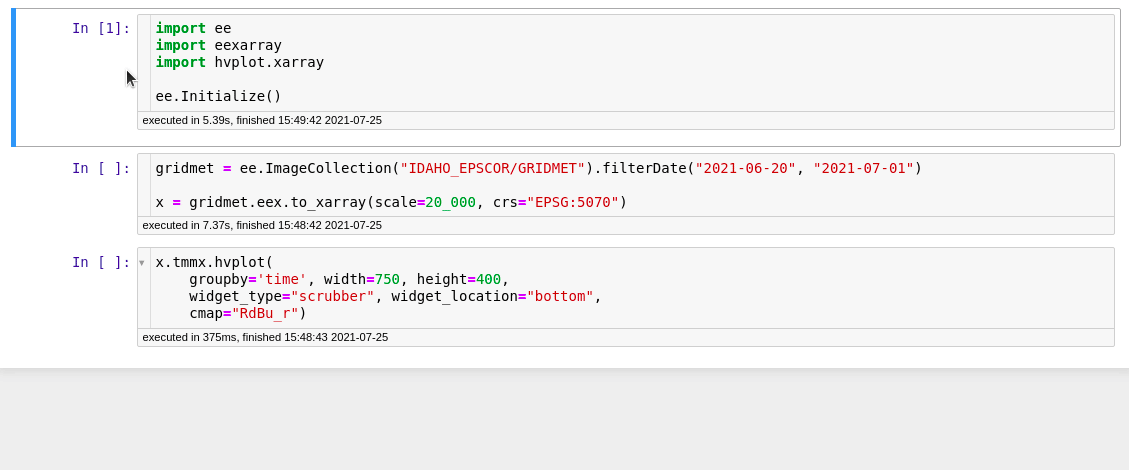A Python interface between Earth Engine and xarray
eexarray was designed to make processing gridded, mesoscale time series data quick and easy by providing a bridge between the data catalog and processing power of Google Earth Engine and the flexibility of xarray and numpy, with no complicated setup required. To accomplish this, eexarray implements convenient methods for data processing and conversion.
- Time series image collections to xarray and NetCDF in one line of code
- Temporal resampling in EE (hourly to daily, daily to monthly, etc.)
- Images and image collections to GeoTIFF
- Parallel processing for fast downloads
- Support for masked nodata values
eexarray isn't built to export huge amounts of data. The "no setup required" approach means it has strict download size limits imposed by Earth Engine's URL downloading system. If you run into download issues, try using a larger scale or splitting images into smaller regions. If you are regularly downloading large amounts of high resolution data, consider using Earth Engine's built-in Drive exporting or a tool like restee.
eexarray also isn't a weather/climate processing toolkit. There are great Python packages out there already like MetPy and ACT, so why reinvent the wheel? eexarray focuses on taking care of the heavy lifting so you can work with your data in domain-specific tools.
Pip and Conda coming soon...
git clone https://github.com/aazuspan/eexarray
cd eexarray
make installCheck out the full documentation here.
eexarray uses the eex accessor to extend Earth Engine classes. Just import eexarray and use .eex to access eexarray methods.
import ee, eexarray
ee.Initialize()
ee.Image( ... ).eex
ee.ImageCollection( ... ).eeximport ee, eexarray
ee.Initialize()
imgs = ee.ImageCollection("NOAA/NWS/RTMA").filterDate("2020-09-08", "2020-09-15")
arr = imgs.eex.to_xarray(scale=40_000, crs="EPSG:5070")import ee, eexarray
ee.Initialize()
hourly = ee.ImageCollection("NOAA/NWS/RTMA").filterDate("2020-09-08", "2020-09-15")
daily_max = hourly.eex.resample_daily(reducer=ee.Reducer.max())import ee, eexarray
ee.Initialize()
img = ee.Image("COPERNICUS/S2_SR/20200803T181931_20200803T182946_T11SPA")
img.eex.to_tif(out_dir="data", scale=200, crs="EPSG:5070")Downloading imagery from Earth Engine can fail due to communication issues with Google's servers. eexarray will automatically retry failed downloads, but if downloads continue to fail you can try 1) setting the max_attempts argument to a higher value or 2) waiting a few minutes and re-running your download.
Bugs or feature requests are always appreciated! They can be submitted here.
Code contributions are also welcome! Please open an issue to discuss implementation, then follow the steps below.
-
Create a fork of eexarray.
-
Download and install the package and developer dependencies from your fork.
git clone https://github.com/{username}/eexarray
cd eexarray
make install-dev- Create a new feature branch.
git checkout -b {feature-name}- Write features and tests and commit them (all pre-commit checks must pass). Add NumPy-style docstrings and type hints for any new functions, methods, or classes.
git add {modified file(s)}
git commit -m "{commit message}"- Rebuild documentation when docstrings are added or changed.
make docs
make view-docs

